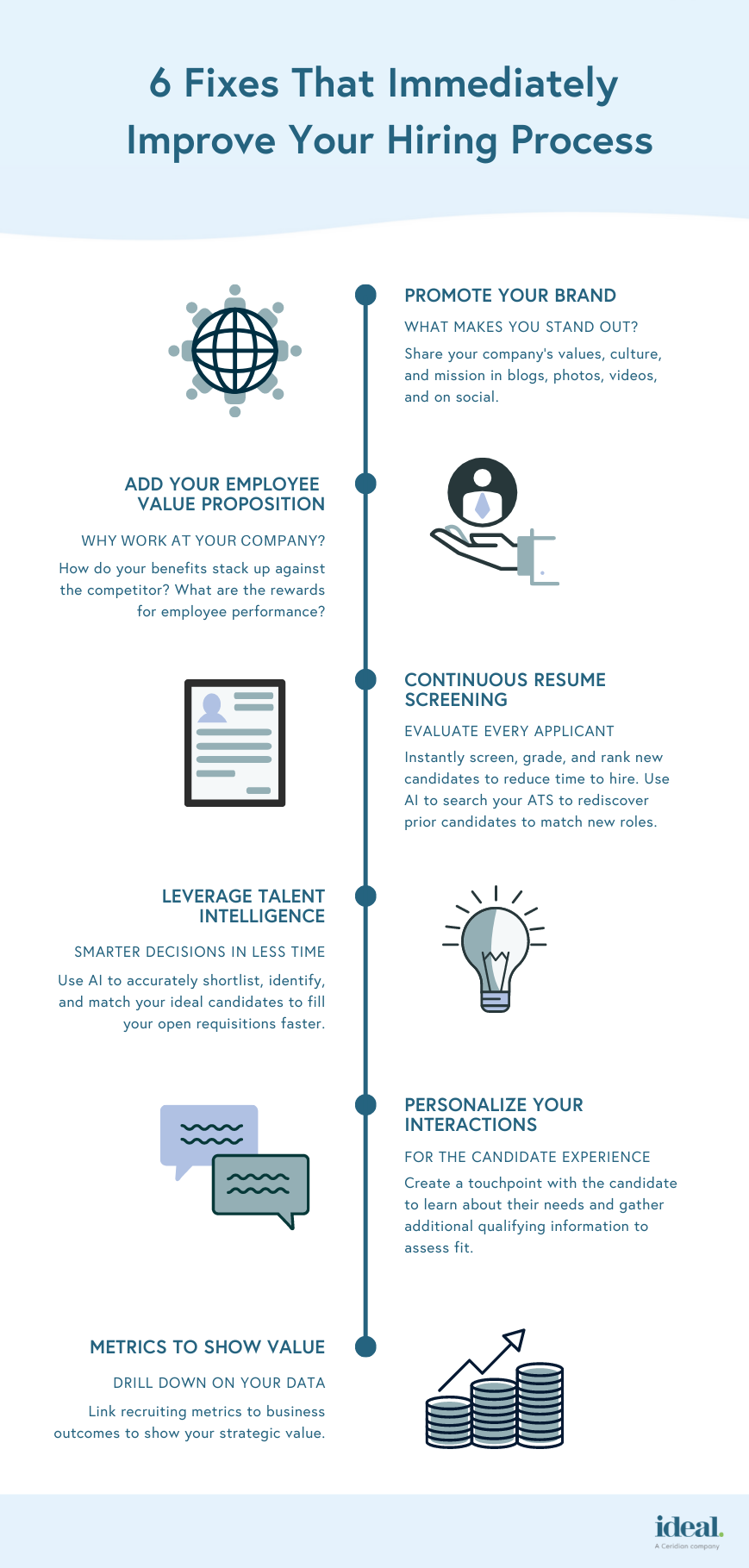The hiring process is only predicted to become even harder this year, and enterprise organizations are turning to talent intelligence for a data-driven strategy. The post-COVID hiring surge has made the ‘war on talent’ even more competitive and fast-paced.
Where to start? See our list of 6 fixes to improve your hiring process summarized in an infographic below.

1. Attract more candidates by promoting your employer brand
A LinkedIn survey found the #1 obstacle for job seekers changing jobs is “not knowing what it’s really like to work at the company.”
This uncertainty is a big reason why recruitment marketing has become so popular. As a central part of recruitment marketing, your employer brand is a reflection of your company’s culture, values, and mission.
Whether it’s through your company’s videos, photos, blogs, and social media posts or third party review sites like Glassdoor, you can dramatically improve your hiring process by ensuring your employer brand is searchable, authentic, and compelling.
2. Improve your job posting by adding your employee value proposition
Improving your job posting is a simple but overlooked fix to improve your hiring process. Most job postings seem to be written as an afterthought, with long, boring, and technical descriptions. Worst of all, they tend to be focused on the company’s perspective rather than the candidate.
Job postings that emphasize how the job fulfils the candidate’s needs not only attracts a greater quantity of applicants, but higher quality of applicants as well.
One of the best ways to highlight this job-candidate fit is to include your employee value proposition. What benefits can the employee expect to receive? How will their performance be rewarded?
Your employee value proposition should include what differentiates the job and company, whether that’s career progression, flexibility, or amazing perks. In light of the COVID-19 pandemic, twice as many job postings are mentioning remote work to attract employees looking for that flexibility. Even for jobs that require on site work, some organizations are being creative with offering flexibility, such as home health care workers that can do adminstrative tasks from home one day a week as opposed to going into the office.
3. Reduce time to hire by automating your resume screening
For every 100 applicants a high volume job posting receives, around 65% are ignored.
In the fast-paced war on talent, enterprise organizations can’t afford to ignore over half of their applications. Automating resume screening and matching with AI-powered software eliminates this resume “ignore problem.”
iCIMS found a resume spends 23% of its time in the screening phase. Using AI to automate your resume screening improves your hiring process because it drastically reduces time to hire without sacrificing quality of hire.
Although the typical large company is sitting on thousand – if not milliions – of resumes, most ATS software lacks the ability to accurately search an existing resume database to match previous candidates to current reqs.
Talent rediscovery solves this issue by using AI to analyze your job description and then search your existing ATS to find candidates who have applied to your company in the past who fit the requirements of the current job opening.
Rediscovering previous candidates improves your hiring process because it eliminates the need to come up with Boolean or keyword searches to conduct a resume search manually, as well as saving on talent acquisition costs.
4. Leverage talent intelligence for data-backed decision making
Is recruiting a gut instinct? Leading enterprise organizations are leveraging the wealth of data within their ATS to make smarter talent decisions and optimize every step in their hiring process.
Talent intelligence refers to using a data-backed approach for every talent decision, from hiring to promotions, and your strategy across the entire employee lifecycle. In 2021, your workforce strategy relies on complete visibility of your global workforce.
How can talent intelligence optimize the hiring process? AI analyzes your existing resume database to learn what the qualifications of successful employees and past hires are. That knowledge is then applied to resume screening, including ranking and candidate grading.
With AI, recruiting teams can increase their hiring accuracy, tap into attrition blind spots, and highlight inequities across your workforce to start making real change.
5. Improve your hiring process by personalizing your candidate experience
A CareerBuilder survey found that the #1 complaint of job seekers about the hiring process is a lack of personalization.
Employer behavior falls short of candidate expectations: while 52% of employers respond to less than half of the candidates who apply, 84% of candidates expect a personal email reply to their application and 52% expect a phone call.
One of the biggest benefits of using technology to improve hiring is reducing the administrative burden and freeing up recruiters’ time to personalize candidate experience.
By automating your resume screening, each and every application can be screened, ranked, and replied to. Recruiters can concentrate on the shortlist of candidates identified as strong matches, for example, all candidates graded as an A.
Recruiters can use this freed-up time to create more in-depth, high-touch relationships with qualified candidates to uncover their needs, determine fit, and persuade them to consider the opportunity.
6. Show your recruiting value by using business-related metrics
Recruiting metrics are measurements that provide insights into the value and effectiveness of your recruiting process.
They provide information for recruiters to identify where process improvements are needed and justify investment into specific recruiting functions.
Measuring recruiting metrics and linking them to business outcomes, for example, reduced costs related to decreased turnover or increased revenue related to hiring top performers, significantly improves your hiring process because it demonstrates your financial and strategic value to the company.
What areas of your hiring process need to be reworked? Learn more about Ideal’s talent intelligence system and how enterprise organizations are recruiting more accurately, efficiently, and fairly with AI.